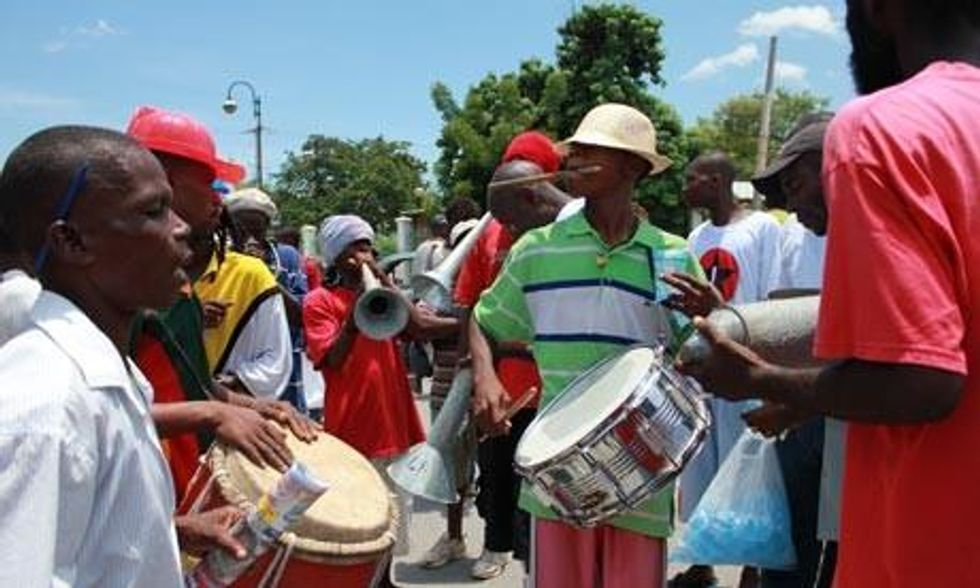In Haiti, you'll see a young man sitting on a crumbled wall blasting a song out of a bashed-up radio and singing along - apparently without irony - lyrics that just repeat "I love my life". You'll see a woman trying to peddle half-rotten papayas from a basket on her head, dancing to kompa on a pile of sewage-soaked rubble and trash. You'll see a barefoot six-year-old boy flying a homemade kite wearing a T-shirt that says "Save Darfur". You can be sure that if your motorcycle, car or SUV breaks down in the potholes of Port-au-Prince, any one of these folks will bend over backwards to help, rather than pose any threat to your safety.
What's remarkable about Haiti is that despite the devastating earthquake, tent camps, cholera, political instability and chronically corrupt and neglected judicial institutions, it couldn't be further from the orgy of violence people around the world associate with it. The United Nation's latest homicide statistics show that Haiti is one of the least dangerous places in the Caribbean region with a murder rate on a par with the US.
This is encouraging news, but it begs the question: what is the world's third-largest UN peacekeeping mission - the only one in the Americas - doing there? They have been there for over seven years with no apparent exit strategy: the UN's blue helmets peep out of white armoured personnel carriers; Brazilian riot police patrol tent camps with weapons drawn; French gendarmes fire tear gas at peaceful demonstrators whenever they're deemed a threat. No, the real violence of Haiti is its continuing lack of civic infrastructure, to the extent that people are dying every day of diseases to which most countries waved goodbye in the 19th century; of failed economic policies imposed from abroad like a laboratory experiment.
Two years on from the earthquake, the official death toll from cholera is now 7,000 and rising with no end in sight. In just over a year, Haiti has gone from having zero cases to having the deadliest cholera epidemic in the world. Though the outbreak was partly due to globalisation and incredibly bad luck, indications that UN troops were the source of the disease have motivated 5,000 Haitians to launch a legal action demanding an apology and compensation for "gross negligence", and "indifference" in the UN mission's initial response. The UN remains unapologetic, despite studies confirming the strain of cholera originated in Nepalese troops' toilets.
The UN's budget for peacekeeping is equal to half the Haitian government's annual spending, and eight times greater than the amount the UN's cholera appeal has raised. In fact, a cholera vaccination campaign for the entire country could be paid for with the equivalent of just 18 days of the UN's Haiti peacekeeping bill.
Haiti was a graveyard of failed NGO projects even before the earthquake, so people are unusually cynical towards both their own government and international actors, and happiest when solving problems themselves. Gardy Guerrier, a community organiser in outer Cite Soleil, Haiti's poorest shanty, says that though they've seen more "noise and propaganda than actual work by the new government" his community is doing much better than last year when things seemed like they couldn't get any worse. After the earthquake, the government started dumping all the city's raw sewage into open air pits in Troutier, the city dump, next to his village; and when cholera broke out, the community organised blockades to prevent the septic tank trucks from entering the junkyard.
It's now exactly two years since the Caribbean fault lines ripped apart one of the most densely populated capital cities in the world and international donors pledged more than $5bn for Haiti's recovery (the largest amount ever for post-disaster reconstruction). A year ago, the commission in charge (co-chaired by Bill Clinton) was floundering; today it's all but fizzled out, having brokered less than half the donor funds pledged.
Some projects have forged ahead - a shiny new wing of the UN headquarters has sprung up, land has been set aside for new garment factories, and there will soon be a new five-star hotel near the airport where foreign celebrities and businessmen can stay when flying in to do a charity photo-op or bid for lucrative reconstruction contracts. "Haiti is open for business" is the new government's motto: but more than half a million people displaced by the earthquake still languish in two-year-old tent camps with no water and sanitation facilities, while almost 80,000 houses deemed damaged beyond repair have been reoccupied.
Textile manufacturing is now at the heart of Haiti's economic development thanks to its duty-free access to the US market, a captive labour force of 70% unemployment and labour costs competitive with China. Haitian workers, however, earn less today than they did under the Duvalier dictatorship, and spend half their average daily wage on lunch and transportation to and from work.
The most egregious consequence of the unpopular military presence is that it has justified the rise of a highly lucrative private security industry whereby earthquake emergency relief funds are spent on bodyguards and bunkers for humanitarian workers rather than meeting the basic needs of the earthquake victims. The lie about Haiti's security threat goes to the very heart of what's been wrong with the international community's mindset toward the country since the earthquake, and for many many years before. You can't fight poverty with an army - not even a blue helmeted one.

